Make Chord Changes with Very Little Movement
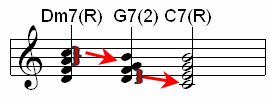 Close Chord Progression is the ability to make dramatic chord changes with slight movement in notes.
Close Chord Progression is the ability to make dramatic chord changes with slight movement in notes.
As can be seen in the graphic to the right the chord movement of a series of fifth changes is accomplished by changing two notes for each chord.
There is so much to discuss here, there is just no way to cover it all in such a short page of information. Therefore, we will focus on the concept of making these close note changes to move to a new chord in a harmonic system.
Start with a Simple Idea of Chord to Chord
Again we use the C major harmonic system and choose two chords to consider in making this close chord progression.

Lets take the C major scale as an example and choose to use C major in the root position and move to an F major.
C root is just as shown above for the tonic position and we notice almost immediately that the F root position is a fairly large jump in notes. Exploring the chord inversions will help us identify the closest combination chord that uses the F chord notes.
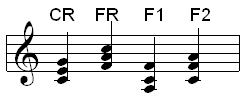 This graphic shows the three options available to change from chords of C root to F chord.
This graphic shows the three options available to change from chords of C root to F chord.
Those options being F root (FR), F first inversion (F1), and F second inversion (F2).
One of the first things you notice is that both of the inversions are much better than the F root position. Now either one could be a good choice.
We need to consider more detail to decide if one might work better than the other.
Common Notes for Close Chord Progression
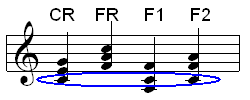 The next thing you will be looking for is what notes are common from one chord to the next.
The next thing you will be looking for is what notes are common from one chord to the next.
In this case both of the inversion have one note in common and that is the C note.
It is not uncommon for chords to share two notes and in extended chords to share 3 or 4 notes. An example of this is shown at the top of the page with the seventh chords.
So this means that you can keep one note the same (a finger on the keyboard doesn’t have to move) and then each of the other notes moves to a near by note.
Notes to Change Are Close Ones
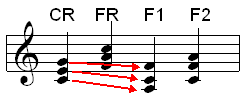 Now you have to go just a little bit deeper to see which music notes are prime candidates to be used in the new chord.
Now you have to go just a little bit deeper to see which music notes are prime candidates to be used in the new chord.
Take a look at F1.
It has the notes of A, C, and F. C is common so you don’t want to move C down to A (a full 2 whole notes or 3 half steps in this case), then E to C (again 2 whole notes), and G to F (one whole note) because that causes all notes to change.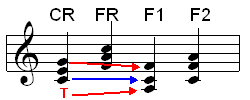
However, if you happen to be playing your keyboard with a second finger on C then your thumb would be free and you would be able to just play the A and F by maintaining the C note.
Apply the thumb to A and then your 4 or 5 finger to F. Then maybe it becomes a better option.
Circumstance plays a part in your choices when making close chord progression decisions.
Best Notes to Change Are the Closest Ones
I’ll bet your looking at the F2 position by now and thinking it’s thebest one. You would be right in most cases. 
On you piano you normally play the C root chord with your thumb, third finger, and fifth finger. (thumb, middle and pinkie fingers).
By holding the thumb and moving the other two fingers to the next to notes up you have made an easy transition.
That is the thumb got to stay in place. The third finger moved a half step from E to F and the fifth finger moved from G to A a whole step.
Very close and easy movement.
Getting Deeper on the ii7 – V7 – IM7 Chord Motion
 We talked about this seventh chord series above. Take a closer look at what happens when we moved two notes at a time. A and C went to E and B to get from the Dm7 to the G7.
We talked about this seventh chord series above. Take a closer look at what happens when we moved two notes at a time. A and C went to E and B to get from the Dm7 to the G7.
The position or chord shapes were root to second inversion to root. But did you realize that if you had not used the G7 chord you would be going from a ii7 to a IM7 (Dm7 to CM7) by moving every note just one note in the scale.
Two of the notes would move a half step (C to B and F to E) and the other two move a whole step (A to G and D to C). The exact same shape was used for both chords.
The G7 in the middle gave you the ability to move two notes at a time instead of all four and provided for musical character and movement.
Close Chord Changes Using All the C Major Chords
In the previous lesson we showed you the chord progress in fifths for the key of C. Here is an example of one close chord progression using that sequence. There are others and you should explore them.

In this series the use of the B diminished chord caused us to be unable to connect the chords with similar notes from F to B. However, every other change has one or two notes that are the same.
Common Note Rules to Help with Close Chord Progression
One Note Common:
- Major to Major Chord in the Key Signature will be one common note. In the example above it was the C note for the chords C to F. It will be the G note for C to G.
- This is true for the minor to minor chordchanges as well. E note for Em to Am chords and A note for the Am to Dm chords.
Two Note Common:
- Chords that are a third away up or down havetwo notes in common. For a I chord the iii and vi chords have two notes. Example of C again. C to Em chord has the E and G notes as common. C to Am (third down) has the C and E notes as common.
No common notes:
- Chords that are next to each other have no
notes in common. C and Dm or D major must move all notes. Same is true for C and B major, minor, and diminished.
Advice on Learning Close Chord Progression
Take your time and explore the inversions. You may go from an inversion to another type or you may find that you have to move all chord notes just one note.
Analyze music in the mean time. See what they have done when it comes to close chord progression. Did they change all the notes or what notes stayed the same.
(This is a nugget on learning, — what stayed the same and then what do I have to change. Amazing things happen when you think this way)
Study the flow of notes and you’re going to get a feel for what that close chord progression concept is all about.
Learning Resources
 Before you buy another music learning book you’d better read this!
Before you buy another music learning book you’d better read this!
Every wondered why musicians can work with songs so quickly? It’s all about the chords and the scales.
Learning to create, recognize and work with chords and scales is essential in mastering music.
It can be intimidating for the beginning student.
Don’t let them get the best of you.
These Getting It Down Cold Workshops easily lead you through the process step by step. And in a fraction of the time that most students take to learn this vital part of music.
Go here to Learn More…
